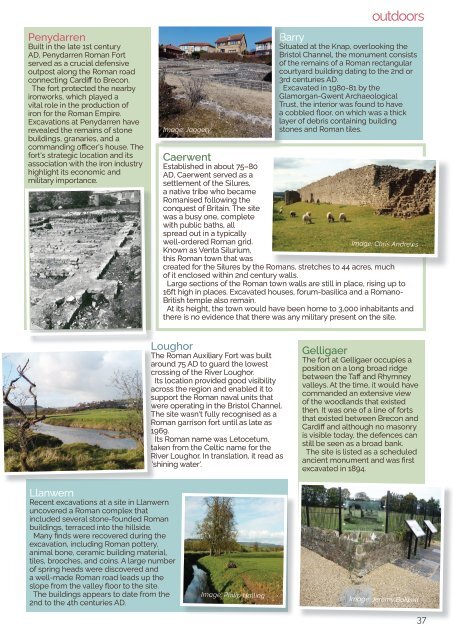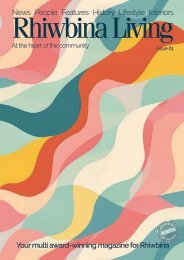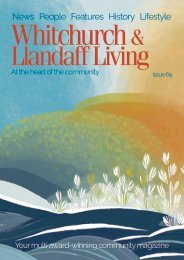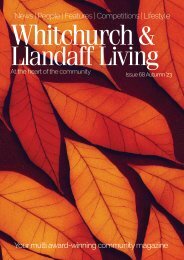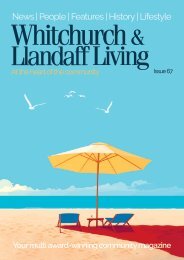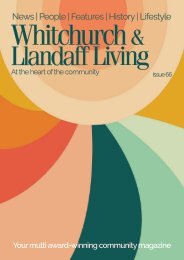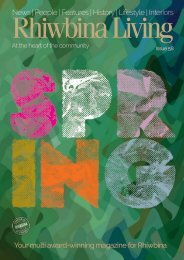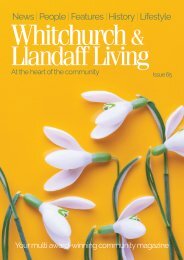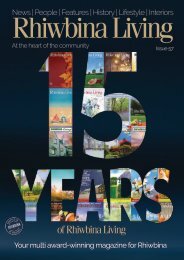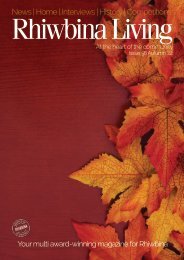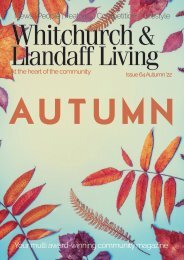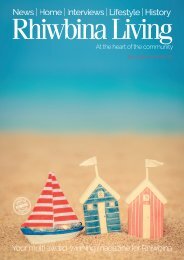Rhiwbina Living
Summer 2023 issue of Rhiwbina Living, the award-winning magazine for Rhiwbina.
Summer 2023 issue of Rhiwbina Living, the award-winning magazine for Rhiwbina.
- TAGS
- wales
- whitchurch
- rhiwbina
- cardiff
You also want an ePaper? Increase the reach of your titles
YUMPU automatically turns print PDFs into web optimized ePapers that Google loves.
outdoors<br />
Penydarren<br />
Built in the late 1st century<br />
AD, Penydarren Roman Fort<br />
served as a crucial defensive<br />
outpost along the Roman road<br />
connecting Cardiff to Brecon.<br />
The fort protected the nearby<br />
ironworks, which played a<br />
vital role in the production of<br />
iron for the Roman Empire.<br />
Excavations at Penydarren have<br />
revealed the remains of stone<br />
buildings, granaries, and a<br />
commanding officer's house. The<br />
fort's strategic location and its<br />
association with the iron industry<br />
highlight its economic and<br />
military importance.<br />
Image: Jaggery<br />
Barry<br />
Situated at the Knap, overlooking the<br />
Bristol Channel, the monument consists<br />
of the remains of a Roman rectangular<br />
courtyard building dating to the 2nd or<br />
3rd centuries AD.<br />
Excavated in 1980-81 by the<br />
Glamorgan-Gwent Archaeological<br />
Trust, the interior was found to have<br />
a cobbled floor, on which was a thick<br />
layer of debris containing building<br />
stones and Roman tiles.<br />
Caerwent<br />
Established in about 75–80<br />
AD, Caerwent served as a<br />
settlement of the Silures,<br />
a native tribe who became<br />
Romanised following the<br />
conquest of Britain. The site<br />
was a busy one, complete<br />
with public baths, all<br />
spread out in a typically<br />
well-ordered Roman grid.<br />
Known as Venta Silurium,<br />
this Roman town that was<br />
created for the Silures by the Romans, stretches to 44 acres, much<br />
of it enclosed within 2nd century walls.<br />
Large sections of the Roman town walls are still in place, rising up to<br />
16ft high in places. Excavated houses, forum-basilica and a Romano-<br />
British temple also remain.<br />
At its height, the town would have been home to 3,000 inhabitants and<br />
there is no evidence that there was any military present on the site.<br />
Image: Chris Andrews<br />
Loughor<br />
The Roman Auxiliary Fort was built<br />
around 75 AD to guard the lowest<br />
crossing of the River Loughor.<br />
Its location provided good visibility<br />
across the region and enabled it to<br />
support the Roman naval units that<br />
were operating in the Bristol Channel.<br />
The site wasn't fully recognised as a<br />
Roman garrison fort until as late as<br />
1969.<br />
Its Roman name was Letocetum,<br />
taken from the Celtic name for the<br />
River Loughor. In translation, it read as<br />
'shining water'.<br />
Gelligaer<br />
The fort at Gelligaer occupies a<br />
position on a long broad ridge<br />
between the Taff and Rhymney<br />
valleys. At the time, it would have<br />
commanded an extensive view<br />
of the woodlands that existed<br />
then. It was one of a line of forts<br />
that existed between Brecon and<br />
Cardiff and although no masonry<br />
is visible today, the defences can<br />
still be seen as a broad bank.<br />
The site is listed as a scheduled<br />
ancient monument and was first<br />
excavated in 1894.<br />
Llanwern<br />
Recent excavations at a site in Llanwern<br />
uncovered a Roman complex that<br />
included several stone-founded Roman<br />
buildings, terraced into the hillside.<br />
Many finds were recovered during the<br />
excavation, including Roman pottery,<br />
animal bone, ceramic building material,<br />
tiles, brooches, and coins. A large number<br />
of spring heads were discovered and<br />
a well-made Roman road leads up the<br />
slope from the valley floor to the site.<br />
The buildings appears to date from the<br />
2nd to the 4th centuries AD.<br />
Image: Philip Halling<br />
Image: Jeremy Bolwell<br />
37


